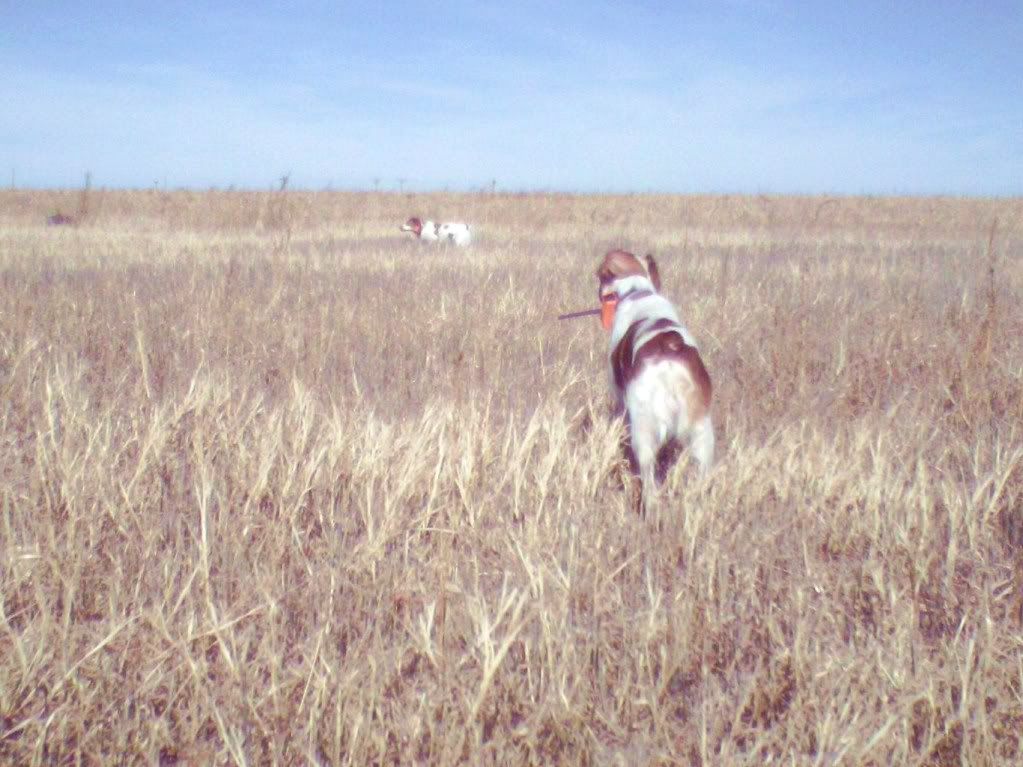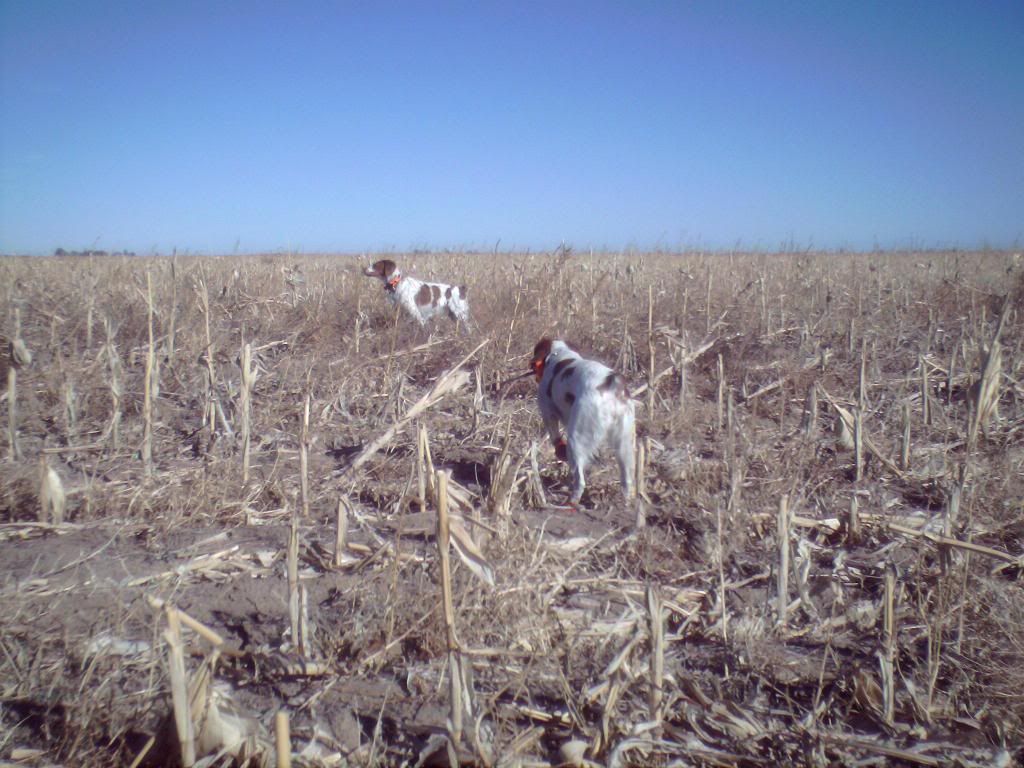You are using an out of date browser. It may not display this or other websites correctly.
You should upgrade or use an alternative browser.
You should upgrade or use an alternative browser.
if- what would you and your dog do
- Thread starter Shadow
- Start date
FCSpringer
Moderator
First I would remove all that hard wear from his neck. then I would tell him to get his ass over there and find and flush the darn bird for me, thats your job not mine you goofy dog.
:cheers::coolpics:
:cheers::coolpics:
bobeyerite
New member
I would go to the far one. I think that is the bird point and the close dog is an honor point. If that dog was my Brittany he would tell me exactly where the bird is as I approached. He do it with his eyes. With his head high like that the bird is out a ways from him. Ok how did I do?.........Bob
GustavDaGSP
Member
Nimrod
Member
The near dog is backing the distant dog & the bird is probably about 20 yds away from him. You’ve got to know which way & how strong the wind is blowing to be more precise. (stronger wind = further find).
I’d expect a pheasant to be skulking away fast in that low cover so I’d curl around the left side in a big enough circle to try & cut him off.
I’d expect a pheasant to be skulking away fast in that low cover so I’d curl around the left side in a big enough circle to try & cut him off.
FCSpringer
Moderator
The near dog is backing the distant dog & the bird is probably about 20 yds away from him. You’ve got to know which way & how strong the wind is blowing to be more precise. (stronger wind = further find).
I’d expect a pheasant to be skulking away fast in that low cover so I’d curl around the left side in a big enough circle to try & cut him off.
Diddo:thumbsup:
Move, smartly toward the pointed bird, at an angle which does not have me running up directly behind either dog, main objective is to get into shooting range before either the bird runs off or wild flushes. It might require a release and relocate judging from the appearance of the point, birds are some distance and may already be moving, dog is saying " get up here boss"! Looks like nice dog work, by dogs used to handling skittish birds. Nice blend of pressure, but not to much!
birdman652001
New member
I would go to the far one. I think that is the bird point and the close dog is an honor point. If that dog was my Brittany he would tell me exactly where the bird is as I approached. He do it with his eyes. With his head high like that the bird is out a ways from him. Ok how did I do?.........Bob
im with bobby on this one..
my dog (GSP) will point but her eyes will tell me the exact location. she glimpse at me quick and her eyes will be on the target when shes in POINT mode.
im guessing distance dog since the distant dog is pointing down and the one thats close in the photo is looking on knowing theres a HOLD on a target and knows dont disturb til ready to flush.
Shadow
Banned
FC- each Britt has the Garmin- these are the old DC20's- which I like- they're every bit as good as the DC40
- hardware! bull- these two get out there 600 yards and lock up
bingo- you stated it correctly- little 16 month female had the pheasant- her dad- although not liking- has started to back her- why- because he can see me and he knows I'm watching- plus- he's come to realize she has a nose and doesn't lock up without a reason
question- would you walk in from the right- coming up alongside the dogs-
would your dogs have maners- not rush in- but honor
this is what I see alot- would you stand back and watch or crowd in to be right there in the action- how about your dogs
I've got more pictures- as sometimes I don't even care if I shoot the bird
- hardware! bull- these two get out there 600 yards and lock up
bingo- you stated it correctly- little 16 month female had the pheasant- her dad- although not liking- has started to back her- why- because he can see me and he knows I'm watching- plus- he's come to realize she has a nose and doesn't lock up without a reason
question- would you walk in from the right- coming up alongside the dogs-
would your dogs have maners- not rush in- but honor
this is what I see alot- would you stand back and watch or crowd in to be right there in the action- how about your dogs
I've got more pictures- as sometimes I don't even care if I shoot the bird
Shadow
Banned
Move, smartly toward the pointed bird, at an angle which does not have me running up directly behind either dog, main objective is to get into shooting range before either the bird runs off or wild flushes. It might require a release and relocate judging from the appearance of the point, birds are some distance and may already be moving, dog is saying " get up here boss"! Looks like nice dog work, by dogs used to handling skittish birds. Nice blend of pressure, but not to much!
whew- you are clever- and experienced- she had two roosters- I chose to take the picture- walk 30 yards to my left- come in watching her- while paying attention to the big guy- because untill recently he doesn't think so much of the pups-
rooster got up close to her- I fired- she stayed there- dang- 1 step- another rooster came up- forgot to look to see what Shadow was doing
Shadow
Banned
I would go to the far one. I think that is the bird point and the close dog is an honor point. If that dog was my Brittany he would tell me exactly where the bird is as I approached. He do it with his eyes. With his head high like that the bird is out a ways from him. Ok how did I do?.........Bob
ahhh bob- you know Brittany's- the eyes- well done
birdman652001
New member
ahhh bob- you know Brittany's- the eyes- well done
thats what i thought. my GSP does the same thing when shes got a target in sight. she'll look at me quick then eyes back on the target giving that short glimpes to me then i know where the bird is.
Shadow
Banned
the eyes- nothing to me is quite so telling- eyes don't move- they've got the bird- eyes move they aren't real sure-
I've taken folks hunting- they see something like these pictures- they want to rush in- hard thing to do- settle down- bird isn't going anywhere
the other thing is- how many feel they need to walk up softly alongside the dog- vs- walk way arround and come in facing the dog
I've taken folks hunting- they see something like these pictures- they want to rush in- hard thing to do- settle down- bird isn't going anywhere
the other thing is- how many feel they need to walk up softly alongside the dog- vs- walk way arround and come in facing the dog
I run two Brittanys and one I do NSTRA field trials with. Because of what's required in the trials this is how I'd approach it, assuming the far dog has the bird and the near dog is backing. First I'd reassure the backing dog to remain steady with a little Whoa command. Then I'd circle around and come in facing the dog with the bird, probably giving that dog a Whoa to keep is steady and then I'd locate and flush the bird. In NSTRA if your dog goes on a back it has to remain steady until you can get to the dog and grab the collar so it doesn't move until the bird has been flushed, shot and retrieved by the other dog and handler. Also when your dog is the one on point the dog cannot move until the handler flushes the bird. It doesn't have to be steady to wing & shot but must remain steady until the flush. Since I've started the NSTRA trials it's changed how I approach a dog on point and/or backing.
thurrealty
New member
If I were quail hunting...I would do one thing....if I thought it was a covey...if I were pheasant hunting....I would circle behind the pointing dog....and ease up with him/her. Also..I would do one thing if I were hunting by myself and another if I were hunting with my hunting buddy. Great pic by the way.
Gove County Britts
New member
SHADOW GREAT PICS I would hold long enough to see witch dog had the bird pinned then circle around and come in in front of the bird and as bob stated the eyes tell you everything if i had my dogs there I would leash them as to not bother yoursmine back but i never want to take the chance on breaking someone elses dogs on point :coolpics:
kansasbrittany
Banned
I echo GCB:coolpics:
They are very good ones, they take you right to the action. I need to take more field photos
They are very good ones, they take you right to the action. I need to take more field photos
bobeyerite
New member
DZ raises a good point on reassuring the pointing dog with a soft "Whoa" command. That is why I like to train whoa with a hand single. Palm toward dog with fingers spread. As I approach the dog from the front I just hold up my hand command and that reassures the dog. No voices to scare the bird........Bob
Shadow
Banned
I run two Brittanys and one I do NSTRA field trials with. Because of what's required in the trials this is how I'd approach it, assuming the far dog has the bird and the near dog is backing. First I'd reassure the backing dog to remain steady with a little Whoa command. Then I'd circle around and come in facing the dog with the bird, probably giving that dog a Whoa to keep is steady and then I'd locate and flush the bird. In NSTRA if your dog goes on a back it has to remain steady until you can get to the dog and grab the collar so it doesn't move until the bird has been flushed, shot and retrieved by the other dog and handler. Also when your dog is the one on point the dog cannot move until the handler flushes the bird. It doesn't have to be steady to wing & shot but must remain steady until the flush. Since I've started the NSTRA trials it's changed how I approach a dog on point and/or backing.
wow- you nailed it- I could go afield with you any day
backing- and that is exactly what I am showing- one dog has the bird- the other dog freezes- because it recognised the other dog has the bird and point- thus locks up when it sees the other dog frozen on point- maners in the field-
I can walk up from behind the dog- but I prefer to walk up facing the dog- pheasants or quail- makes no difference- walking up facing the dog reasures the dog- plus- you see the eyes- the dog sees or knows exactly what you are doing
instead of being so concerned with killing the bird- take your camera and take some pictures- a good dog isn't going to bust the bird just because you are coming in to take a picture- every one of these the pheasant was still there when I put the camera away and flushed the bird-
in my opinion- it makes for a much better dog- the dog is there- has established the point- is not going to move- old and young- I think a good dog knows it has the bird- and is waiting- frozen on point- knowing
another dog must know what it means to back/honor- or you can't expect the dog to point and hold with another dog arround-
so- would your dog freeze- not move at all- when it saw these locked up- or- how far would your dog crowd in- when would it freeze- or would it not lock up in an honor- thus- can't be in the same field


